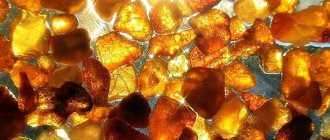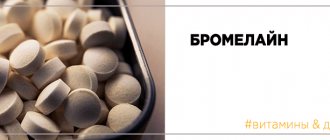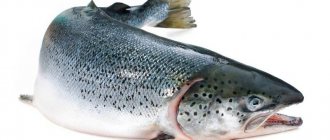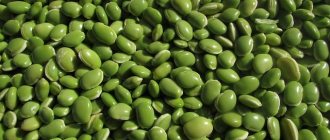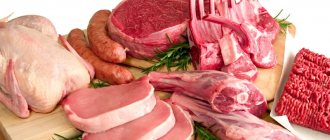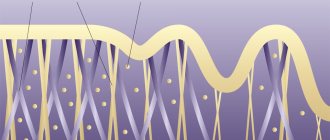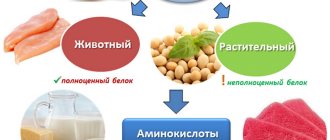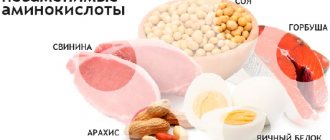Since gluten is a component of wheat protein, it is found in all products made from wheat. First of all, we are talking about pasta, bread, pancakes and sweet pastries. Also, the list of products with gluten may include condensed milk, ice cream, vegetable purees and even various sauces.
In such food products, gluten is used as a thickener - it is due to its content in the composition that a pleasant airy texture is achieved. Let us remind you that gluten proteins have a unique ability to retain gas - which creates both benefits and harm.
The role of gluten in human life
In dry form, gluten is a practically colorless powder, tasteless and odorless. When in contact with water, gluten swells, turning into a viscous mass. It has adhesive properties, hence the name of the substance.
On a note! In the food industry, the homogeneous structure of moistened gluten is of greatest value, as it helps achieve a creamy product.
The role of gluten in human life is quite important. This substance is used as:
- natural food preservative;
- natural thickener;
- component for improving the quality of bakery products;
- household glue.
Most often, gluten is used to knead dough when baking flour products. After all, it is gluten that makes the dough viscous and pliable. As a result, the finished product is soft, porous and satisfying. Bread that contains a lot of gluten is considered first-class. In this regard, breeders from all over the world are trying to introduce varieties of cereals with a gluten content of 30%.
What is gluten? Biochemical characteristics
Gluten is a plant protein found in many plants and primarily predominates in grain crops. Together with other proteins that make up plants, it is called gluten. The higher the gluten content in grain flour, the more valuable it is to bakers when making bread.
Gluten is the basis of gluten, and it gave it its name (translated from Latin - gluten, “glue”).
Gluten gives the dough viscosity and elasticity, with its help the dough rises and retains its shape. The quality of bread directly depends on gluten. Plant proteins compensate for protein deficiency in human nutrition, serving as a significant supplement to animal proteins.
According to its physicochemical parameters, gluten is a tasteless viscous mass consisting of 6 types of amino acids, the main of which are gliadin and gluten. In addition, gluten contains carbohydrates, lipids and minerals in small quantities. Its nutritional value is low compared to proteins such as globulin and albumin.
Harmful properties of gluten
Grain products such as wheat, barley and rye have long been known to mankind. Recently, breeders have been working on introducing new varieties of cereals that will be unpretentious, but at the same time will stand out for their high yields. In addition, it is planned that these grains will contain large amounts of gluten, the breakdown of which in the human body forms larger molecules than when consuming products from conventional cereals. And since it is much more difficult for the digestive system to digest them, new varieties of grains will not be very useful for human nutrition.
Thus, a significant amount of gluten requires the body to work hard to break it down. Remains of gluten that have not had time to digest gradually accumulate. This causes dysfunction of the digestive system and causes excess body weight.
If you constantly eat foods containing gluten, inflammatory reactions develop in the intestines and the permeability of its walls increases. Based on this, it is recommended to enrich your diet with gluten-free foods.
What foods contain casein?
The main sources of casein are milk (cow's, goat's), kefir, yogurt, sour cream, yogurt, fermented baked milk, cottage cheese and curd products, butter. The record holder for its content is cheese. It contains up to 30% of this healthy natural protein. You will also provide your body with casein by consuming chocolate and dairy-based baked goods, such as cottage cheese muffins, cheesecakes or cheesecakes with cottage cheese. However, you understand that it is better to eat cheese or drink a glass of milk than to eat cheesecake (if your goal is to saturate the body with casein or provide it with energy).
List of foods containing gluten
It is not for nothing that gluten is called “wheat protein”, because it is wheat that breaks records for the content of this substance. A large amount of it is included in products made from flour.
Thus, gluten is found in the following list of foods:
- cereals: wheat, oats, rye, barley;
- plant products from these cereals: bran, semolina, bakery products, pasta;
- compote, lemonade, fruit drink, juice, kvass and other non-alcoholic drinks (not too high gluten content);
- sausages;
- instant porridges and soups - these products use gluten as a thickener;
- breakfast cereals, ready to eat;
- mustard, mayonnaise;
- fast food products;
- candies;
- semi-finished products;
- crab sticks;
- canned products;
- confectionery powders;
- undistilled vodka.
Thus, the list of products containing gluten is quite wide. Gluten is often included in sports nutrition products.
In addition, traces of “wheat protein” are found in the following products:
- salo;
- butter;
- low quality vegetable oil;
- industrially processed nuts and seeds;
- sauces;
- canned vegetables of puree consistency;
- ice cream;
- processed fruits;
- dried fruits and candied fruits.
On a note! Coffee granules contain gluten, which makes the powder more crumbly and soluble. Gluten is also added to cocoa to reduce the cost of chocolate production.
So what can you do to avoid the harm of gluten? In fact, the products from the above lists can and even should be consumed, but not in excess. The diet must be supplemented with gluten-free food.
Scope of application of gluten
Gluten has found wide application in many industries.
Below are the main ones:
- Bakery production and production of confectionery and baked goods. With the help of gluten, we not only achieve dough elasticity, but also increase the shelf life of finished products. Gluten significantly improves the physical and chemical properties of produced bread.
- Production of pasta . What is important here is to obtain a high quality product, which is determined by the shape. Gluten is responsible for giving pasta its shape. It is also a binding component in the dough.
- Meat processing industry . Gluten is used as a special food additive to increase the density of semi-finished meat products. Its use is especially relevant when replacing meat with proteins.
- Production of various frozen semi-finished products : dumplings; ravioli; dumplings; puff pastries.
- Production of breakfast cereals, mixtures, bran . To increase the protein component, wheat gluten is added to the product.
- Dairy industry . Gluten is added to baby food and milk formulas. Curd bars and glazed cheese curds, as a rule, also contain it in their composition.
- Pharmaceutical industry : A number of medications contain gluten.
- Alcohol industry . Gluten is a mandatory additive in some drinks.
Gluten Content Table
Below is a table with a list of products that contain gluten in either explicit or hidden form.
| Products with obvious gluten content | Products with hidden gluten content |
| Pancakes | Mustard |
| Waffles | Baby food (canned) |
| Vermicelli | Chewing gum |
| Granular cottage cheese | Yogurt (with additives) |
| Cupcakes | Cocoa powder |
| Crackers | Sausages |
| Pasta | Canned meat |
| Semolina | Canned vegetables |
| Semi-finished meat products | Canned fish |
| Oats | Cutlets |
| Oatmeal (flakes) | Instant coffee |
| Barley porridge | Crab sticks |
| Cookie | Mayonnaise |
| Cakes | Margarine |
| Wheat, porridge | Ice cream |
| Rye | Dumplings |
| Soy sauce | Beer (as an additive) |
| Drying | Instant chocolate drinks |
| Cakes | Soy sauce |
| Breakfast cereal | Sausages |
| Barley | Processed cheese |
| Barley porridge | Meatballs |
Thus, gluten is found in plant foods and food products in which gluten is added during the manufacturing process as a thickener or for other purposes.
On a note! In the production of beer, gluten is necessarily used, since in this case it acts as a preservative. However, gluten-free drinks, which have been gaining popularity recently, are even more harmful. The fact is that the lack of gluten in it is compensated by flavor enhancers and other harmful substances.
Daily gluten intake for adults and children
The human body's need for proteins is determined by the need to establish a balance of nitrogen, which is constantly lost during the metabolic process. A lack of protein food invariably leads to the fact that the body is forced to break down its own protein to maintain balance, which negatively affects the functioning of internal organs.
The consumption rate depends on gender, age, type of activity and the state of the external environment in places of residence. The bulk of the protein consumed should be of animal origin.
List of foods containing gluten
Plant proteins supplement the daily requirement and are represented in the diet of most people by gluten contained in bread, pasta, bakery and confectionery products, and meat products. The list of gluten-containing products goes on.
The table below shows the daily consumption rates for different categories of adults and children:
| Category of population by occupation | Age parameters | Daily protein requirement, g | |||
| Men | Women | ||||
| Total proteins | Including plant | Total proteins | Including plant | ||
Knowledge workers | 18-40 40-60 | 96 89 | 38 36 | 82 75 | 33 30 |
| Workers with low physical activity | 18-40 40-60 | 99 92 | 45 42 | 84 77 | 38 34 |
| Workers with average physical load | 18-40 40-60 | 102 93 | 46 42 | 86 79 | 39 35 |
| Heavy physical workers labor | 18-40 40-60 | 108 100 | 54 50 | 92 85 | 46 43 |
| Unemployed older people | 60-70 Over 70 | 80 75 | 32 30 | 71 68 | 28 27 |
| Students | — | 113 | 45 | 96 | 38 |
| Athletes during competitions | — | 154-171 | 77-85 | 120-137 | 60-68 |
| Women expecting a baby | — | — | — | 109 | 44 |
| Nursing mothers | — | — | — | 120 | 48 |
| Babies | 0,5-1 1-1,5 1,5-2 | 25 48 53 | 5 -0 12 13 | ||
| Preschool children | 3-4 5-6 | 63 72 | 19 25 | ||
| Children of primary school age | 7-10 | 80 | 32 | ||
| Children Wed. school age | 11-13 | 96 | 38 | ||
| Teenagers of high school age | 14 -17 | 106 | 42 | 93 | 37 |
Gluten Free Products Chart
There is no gluten in animal products. In addition, it is not found in some types of plant foods. Below is a table with a list of gluten-free products.
| Products of plant origin | Animal products |
| Pea flour | Dairy |
| Buckwheat porridge, buckwheat | Fish |
| Potato | Meat |
| Corn | |
| Dried apricots | |
| Flaxseed flour | |
| Honey | |
| Bean flour | |
| Chickpeas |
Sample gluten-free menu for the week
While following a gluten-free diet, you can consume any permitted foods, in any quantities and at any time.
Gluten-free diet - recipes recommended by nutritionists:
- vegetarian soups (vegetable, mushroom);
- meat broths;
- boiled porridge, potatoes;
- dairy products;
- salads and seafood;
- fresh, boiled or baked vegetables;
- hard-boiled eggs, steam omelettes;
- boiled, stewed or baked meat;
- fruits and berries, jelly;
Monday
- Breakfast: poached fish with mashed potatoes, tea.
- Lunch: light broth, steamed cutlets with rice.
- Afternoon snack: fruit salad.
- Dinner: buckwheat pudding with fresh vegetables.
Tuesday
- Breakfast: boiled meat with buckwheat porridge, tea.
- Lunch: vegetable soup, fruit jelly and fresh vegetables.
- Afternoon snack: baked apple, preferably with nuts.
- Dinner: boiled meat with rice, rosehip infusion.
- Breakfast: corn flakes, cottage cheese, tea or cocoa.
- Lunch: fish soup or fish soup, baked chicken fillet with buckwheat porridge, black tea.
- Afternoon snack: rice bread with jam, tea.
- Dinner: vegetable stew, gluten-free bread, kefir.
Thursday
- Breakfast: light omelet, cheese, tea.
- Lunch: broth, celery and apple salad, juice.
- Afternoon snack: fruit jelly and compote.
- Dinner: buckwheat pudding with vegetable side dish, green tea.
Friday
- Breakfast: cottage cheese enriched with calcium, baked apple, tea.
- Lunch: steamed cutlets with milk sauce, meat broth.
- Afternoon snack: fruit.
- Dinner: steamed fish cutlets with mashed potatoes, juice.
Saturday
- Breakfast: poached fish with rice, coffee.
- Lunch: broth with meatballs, baked vegetables, tea.
- Afternoon snack: gingerbread with nuts and apples.
- Dinner: boiled meat with buckwheat porridge, kefir.
Sunday
- Breakfast: fruit, cottage cheese, tea or juice.
- Lunch: meat broth, pilaf, vegetable salad, juice.
- Afternoon snack: fruit jelly.
- Dinner: buckwheat pudding, vegetables, tea.
1 day
- Breakfast: cottage cheese dessert with natural fruits, honey, rice cakes, natural cocoa.
- Lunch: baked fish with herbs, mashed potatoes, green salad, berry compote.
- Afternoon snack: lean corn flour bun, natural jam, natural coffee with milk.
- Dinner: millet porridge, kefir.
Day 2
- Breakfast: rice porridge with fresh berries, almond flour bun, natural coffee with milk.
- Lunch: meat borscht or cabbage soup.
- Afternoon snack: rice or cornbread, fruit salad.
- Dinner: buckwheat porridge with goat milk, soy bread.
Day 3
- Breakfast: cheese omelet, corn tortilla, cocoa.
- Lunch: chicken broth, buckwheat pancakes with meat.
- Afternoon snack: banana, tea.
- Dinner: stewed vegetables with sour cream, freshly squeezed juice.
4 day
- Breakfast: corn flakes with milk.
- Lunch: fish soup with boiled egg, stewed beans.
- Afternoon snack: baked apple with nuts.
- Dinner: cottage cheese casserole with rice flour, tea.
5 day
- Breakfast: pancakes made from a mixture of rice and corn flour, cocoa.
- Lunch: creamed cheese and spinach soup, tomato and cucumber salad, boiled breast.
- Afternoon snack: boiled egg, berry juice.
- Dinner: Baked vegetables with cheese, tea.
Day 6
- Breakfast: rice and boiled fish, tea with milk.
- Lunch: meat broth and meatballs, steamed vegetables.
- Afternoon snack: fruit juice jelly, buckwheat bread.
- Dinner: buckwheat porridge and boiled meat, tea.
- Breakfast: low-fat cottage cheese, cocoa.
- Lunch: vegetable soup, baked fish in milk sauce.
- Afternoon snack: muesli of nuts, apple and rice flakes, tea.
- Dinner: vegetable stew
Gluten free diet for weight loss
Recently, show business stars are simply obsessed with the newfangled gluten-free diet, which helps to lose weight. There are even admiring reviews from celebrities showing off their curves. A gluten-free diet involves limiting foods containing gluten, and more restrictive types of diets completely exclude such foods. Among doctors there are also supporters and opponents of such nutrition.
Undoubtedly, a gluten-free diet has certain advantages:
- reduces the amount of high-calorie foods in the diet - foods with gluten contain many calories;
- increases the amount of vegetables in the diet - vegetables are loaded with vitamins and other beneficial components, and are also a source of healthy fiber;
- contributes to the health of the human body.
Opponents of the gluten-free diet criticize this approach to nutrition. In their opinion, products containing gluten provide the human body with important components, so they should not be completely excluded from the diet. In addition, the quality of food is also important. If it is natural, then the gluten content in it will not harm your health. If, in addition to gluten, it contains preservatives and dyes, it should not be eaten.
On a note!
According to scientists, many manufacturers include flavors, sugar, fat and other substances in their products to compensate for the lack of gluten. In fact, such products, although gluten-free, pose a greater danger to the human body than foods containing gluten, and contribute to the accumulation of fat deposits. READ OTHER INTERESTING ARTICLES ON THE TOPIC
- Why take Omega-3?
- What is gluten?
- Gluten Free Products
About the benefits and harms of gluten
Gluten has been gaining popularity recently. Many people talk about it, including famous personalities who follow a gluten-free diet and actively advertise it.
But is it worth sticking to? Should healthy people look for organic products labeled “gluten-free”? To get answers to these dilemmas, it is worth talking about the pros and cons. What do we classify as benefit?
- Gluten increases the nutritional value of food, in turn, this leads to the replenishment of the body not only with energy, but also with additional nutrients and plant proteins;
- Gluten is able to bind many nutrients and minerals, thereby aiding digestion;
- This plant protein contains vitamins A, E, a group of vitamins B and D, P (phosphorus), Ca (calcium), Mg (magnesium) and Fe (iron), as well as many essential amino acids that perform essential functions in our body.
Now let's talk about the dangers of gluten on the human body. There are approximately 1% of people on Earth who suffer from a disease called celiac disease. This is complete gluten intolerance. The mechanism of this disease is very scary, moreover, if a person with this disease does not pay attention to it early, he can bring himself to the grave with his own hands.
Celiac disease is a genetic autoimmune disease characterized by intolerance to gluten.
The immune system of people with celiac disease perceives this protein as a foreign substance and begins to actively fight it. The patient's leukocytes “release” cytokines that destroy the intestinal mucosa.
The villi lining the walls of the small intestine “fall off,” and the bald intestine is unable to absorb nutrients.
Such people will react worse each time to gluten, because the antibodies remember the aggressor, and if measures are not taken in time, it may be too late.
Many people have a hidden intolerance to this protein, its manifestation is weak, so this can be found in a set of medical procedures and confirmed with a special test.
But there is simply an allergic reaction to this protein. There are more such people, but still, it is better to know about what can harm the body.
The immune system of such people perceives gluten as a foreign material and begins to attack it, and even the smallest doses can cause severe allergies, which primarily affects the stomach, intestines, and nervous system.
But the next time you take gluten, the body will also accept this aggressor, the condition will not worsen, the intestinal walls will not be destroyed, since immune cells do not “remember” the foreign material, as is the case with celiac disease.
From a medical point of view, an allergic reaction to gluten is not as severe as celiac disease, but both are better off following a gluten-free diet.
Note: Celiac disease is a serious disease. Women who want to get pregnant should remember the high probability of miscarriage and the danger of giving birth to a child with congenital malformations.
But what should people do with gluten who do not have a congenital intolerance or allergy to this protein?
Scientists have not yet established exactly how much gluten threatens human health. Thanks to long-term selection, grain plants have been modified (they have much more gluten and, as a result, nutritional value).
If a person has a negative reaction to the increased gluten content in a product, he should limit his intake of this protein.
And yet, experimenting with your health yourself is dangerous, because poor nutrition and irreplaceable deprivation of the body in a number of nutrients and amino acids can lead to catastrophic consequences.
To prevent this, you should consult a doctor and carry out a number of necessary medical procedures.
In addition, it is worth remembering that a gluten-free diet is healthy, and losing extra pounds with its help is difficult, although it is possible.
Many people consider this diet to be a healthy lifestyle. In principle, if you exclude large amounts of alcohol, sweet soda, fast food and “quick” snacks (chips, crackers, etc.) from your diet, your gluten intake will decrease and your weight will also decrease.
But if you replace regular processed foods with gluten-free ones for healthy people, there will be less benefit, because more fat and sugar are added to such products. You can purchase a gluten-free organic product next to products for diabetics.
Bottom line: In order for healthy people to benefit from gluten, it is worth consuming it in limited portions, and also try to avoid processed foods, large quantities of confectionery creations, and buy whole grain bread.
People with gluten intolerance are advised to follow a diet, and people with celiac disease are advised to completely eliminate the life-threatening protein.
Gluten intolerance in children
If a child’s body is intolerant to gluten, the child should stop eating foods containing it.
On a note! Children at an early age often experience gluten intolerance, which is associated with an insufficiently mature digestive system. That is why modern pediatricians strongly recommend introducing gluten-free products into a child’s complementary foods first.
Gluten intolerance (celiac disease) is manifested by allergic reactions. The disease is temporary or permanent. In the first case, you will have to give up foods containing gluten for a certain period, and in the second, you will have to stick to diets for the rest of your life.
In general, parents of children with celiac disease should adhere to the following recommendations:
- separate a cabinet for storing gluten-free products;
- Prepare food for a child using separate utensils;
- Wash your hands regularly, especially before handling gluten-free products, to avoid accidentally introducing gluten onto them;
- It is prohibited to use the same oven for simultaneous baking of gluten-containing and gluten-free dishes;
- there is no need to listen to the advice of other parents whose children also suffer from gluten intolerance regarding the safety of a certain product, each body is individual;
- it is better to put prohibited products in a place inaccessible to the patient;
- if a new product is introduced, on the same day it is forbidden to give another type of food that is unfamiliar to the child’s body.
On a note! Scientists agree that celiac disease is inherited. That is, if one of the parents has this disease, the probability of it affecting the child is 50%.
Gluten intolerance, which is permanent, cannot be completely cured, but unpleasant symptoms can be avoided if you follow a gluten-free diet throughout your life.
How to find out if you have gluten intolerance
Not every person wants to risk their health, so many people, having heard about gluten and its harmful properties, want to find out whether they have an individual intolerance to this protein. But is it possible to find out this at home?
To begin with, you should pay attention to the following signs:
- Diarrhea, cramps, constipation, Crohn's disease;
- Diseases of the central nervous system;
- Autoimmune diseases such as osteoporosis, chronic fatigue and insomnia, anemia;
- Depression, sudden mood swings;
- Hormonal imbalance;
- Pain in muscles and joints;
- Numbness of the legs;
- Lack of vitamins;
- Liver problems;
- Bloating and tenderness of the abdomen;
- Dermatitis, skin rash;
- Stomatitis;
- Weak immunity;
- Autism;
- Senility;
- Frequent headaches;
- Developmental delay in a child.
There are a lot of symptoms, it is difficult to diagnose a particular disease based on them. If a person suspects celiac disease or allergic intolerance to gluten, then it would not hurt him to exclude this protein from his diet for 30 days and monitor his condition. If the symptoms weaken or stop, most likely the cause has been found.
But you should not self-medicate, as you can cause irreparable harm to the body! If a person has serious reasons to believe that he has celiac disease, then he should consult a doctor and get qualified help.
Pharmacies now sell various tests to detect an allergic reaction to gluten; anyone can purchase them, because even the price category will allow the average person to do this.
Gluten-free food list
Congenital intolerance to foods containing gluten - celiac disease - brings a lot of trouble to people suffering from it. Even a small amount of pure gluten accidentally introduced into the diet can cause inflammation in the small intestine. But gluten is used in the production of a wide variety of products consumed by humans, and is extremely in demand in the cuisine of vegans and vegetarians. And yet, a list of gluten-free products exists and makes it possible to create a specialized diet.
If a product is labeled “gluten-free,” it means it does not contain gluten.
Cereals and porridges
Not all grains contain protein, which some people have difficulty digesting. To prepare porridges, you can use gluten-free cereals from the following list:
- buckwheat;
- corn;
- rice;
- sorghum.
It is allowed to include legumes in a gluten-free diet - peas, soybeans, lentils.
Regarding oats, you can often find opposite opinions - both that they do not contain gluten, and that they are prohibited products for celiac disease. It may seem surprising, but both theses are true. As a Canadian study showed, there is indeed no gluten in oats, but there is another protein - avenin, which is related to gluten. For this reason, oats can cause individual intolerance.
For products such as oatmeal cookies or instant cereal, these products contain both avenin and gluten. The latter appears due to the peculiarities of production, when wheat, rye or barley components enter the final product.
Warnings that the product contains traces of gluten can be found on packages even with safe cereals and legumes.
Pasta
For many people, pasta is an integral part of their diet, so switching to a gluten-free diet can be quite stressful. Manufacturers producing gluten-free products have found a solution to this problem that will benefit consumers. For example, gluten-free pasta from MAKFA is made from corn and rice flour.
Fusilli brand pasta made from rice and two types of corn flour (white and yellow) is also gluten-free. This Italian product (pasta) comes in different types:
- spirals;
- feathers
- spaghetti.
Information on the pasta of these brands guarantees the safety of consumption of these products by people with celiac disease.
Gluten-free pasta series “Makfa”
Cookie
Gluten-free cookies are made from several types of flour - corn, rice, oatmeal. Quite often, gluten-free cookies are simultaneously a dietary product for those who are lactose intolerant - milk sugar, and for diabetics. All these nuances are usually indicated on the packaging of specific products.
You can not only buy gluten-free cookies (trademarks Bebi, Gullon, Honey Stinger) but also prepare them yourself. This benefit would be a good addition to a gluten-free diet indicated for celiac disease.
Bread
Many food companies produce gluten-free bread - “Dr. Kerner", "Sugaroff", "Healthy" and others. Bread can be purchased:
- rice with vitamins;
- Crispy Corn Rice Caramel;
- rice with dark chocolate;
- buckwheat with dietary vitamins;
- rice and corn without gluten and lactose;
- amaranth with Jerusalem artichoke and others.
If a child or adult has diabetes or lactase deficiency, this does not necessarily mean that they need to eat gluten-free foods. Only a doctor can give such a recommendation based on laboratory blood tests.
Healthy bread
Soy sauce
In the recipes of many soy sauces, gluten is present as a food additive - a thickener. Gluten-free soy sauce, like most gluten-free products, costs significantly more (about 6-7 times). The production of such products is carried out by The New Primal, Brianna X, Kikkoman and others.
Sweets
The “Gluten Free” mark can also be seen on children’s favorite sweets – candies and marshmallows. It can be:
- pastille “Apple” from Pasti Food;
- citrus candy from Candy Tree;
- Apple-Blueberry candies from Bob Snail;
- marshmallows from Smart Sweets;
- apple marmalade from “Sweet World” and other products.
When selecting sweet delicacies, you should pay attention to other characteristics. Many of these products are made without added sugar or lactose, which makes them suitable for use in the diet of people with diabetes or lactose intolerance.
Baby food
It is not always possible to diagnose celiac disease in a young child in a timely manner, since the symptoms of celiac enteropathy usually create a false clinical picture. Symptomatically, celiac disease is similar to iron deficiency anemia, rickets, and anorexia. Children exhibit:
- chronic diarrhea;
- delayed physical development;
- poor appetite;
- capriciousness.
Signs of celiac disease
Typically, symptoms appear by 9-18 months, that is, by the time when, in addition to breastfeeding, complementary foods are actively included in the children's menu. It has been noticed that in children who are bottle-fed, this disease is detected earlier. In this case, the problem of gluten-free baby food becomes urgent. Baby cereals, purees and other gluten-free products can be chosen from organic baby food brands:
- "Spongebob";
- “Eat Healthy”;
- "Smart Sweets"
The companies producing mixtures are Healthy Times, Heins, Gerber, Spelenok, Agusha, Babushkino Lukoshko and many others. Very popular gluten-free porridges from this list:
- dairy-free oatmeal from Hipp;
- dairy-free Remedia;
- dairy-free corn with prebiotics from Fleur Alpine;
- milk oatmeal with banana FrutoNyanya;
- milk rice with apple from Nestle;
- milk buckwheat Bebi.
When choosing gluten-free cereals for your baby, it is worth discussing the advisability of using them with your pediatrician.
If a child does not have problems digesting gluten, there is no need to strive for specialized nutrition just because it is considered fashionable.
What does excess lactose lead to?
With a large amount of lactose, bloating, loose stools, or, conversely, constipation are possible. Also, excessive consumption of milk sugar causes allergies. If you are lactose intolerant, you should therefore avoid products containing it. It can be either a congenital disease or one that arises with age (in older years). The occurrence of lactase deficiency with age is quite normal. It is caused by low consumption of milk and dairy products. This is treated by taking the lactase enzyme, which replaces lactose.
